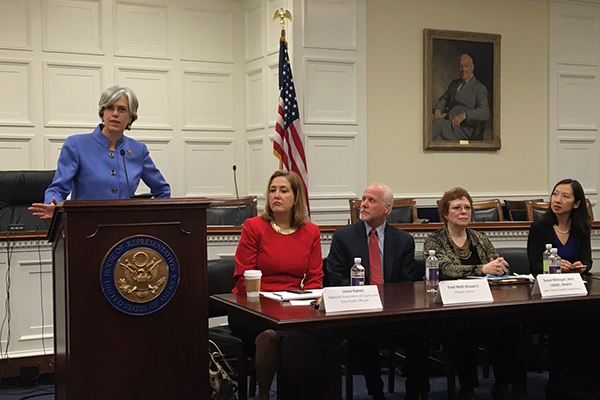
From left: Rep. Katherine Clark (D-MA); Laura Hanen, NACCHO; Fred Wells Brason II, Project Lazarus; Susan McKnight, Lake County (IL) Health Department; and Dr. Leana Wen, Baltimore City Health Department
By Aliyah Ali, Government Affairs Intern, NACCHO
During the second full week of April, NACCHO hosted two briefings for Members of Congress, Congressional staff, and public health advocates: “Tobacco 21: Raise the Age to Save Lives” and “Opioid Overdose and Naloxone: Lessons Learned in Saving Lives.” Public health experts on both issues convened to explain the benefits of raising the age for purchase of tobacco to 21 years and discuss the life-saving abilities of naloxone.
Tobacco 21: Raise the Age to Save Lives
On April 14, NACCHO, Big Cities Health Coalition (BCHC), Trinity Health, and Campaign for Tobacco-Free Kids joined forces to highlight the Tobacco to 21 Act (S.2100/HR 3656), a bill introduced by Senator Brian Schatz (D-HI) and Representative Diana DeGette (D-CO) that would make 21 the minimum age to buy tobacco. According to the report Public Health Implications of Raising the Minimum Age of Legal Access to Tobacco Products by the Institute of Medicine, almost 90% of smokers report that they started smoking before the age of 19 and nearly 100% of smokers report that they started before the age of 26. In the same report, research shows that raising the age to purchase tobacco products reduces the number of young adults who start smoking and reduces adult smoking by 12%.
Building upon the findings of the report, experts discussed the benefits of “Tobacco 21” based on their own experience. The panel included Dr. Robert Crane from the Preventing Tobacco Addiction Foundation, Matthew Myers from the Campaign for Tobacco-Free Kids, Dr. Bechara Choucair from Trinity Health, Dr. Sonia Angell from the New York City Department of Health and Mental Hygiene, and Scott Hall from the Kansas City Chamber of Commerce. Tonya Wells of Trinity Health moderated the panel.
Currently, 135 localities have enacted the legislation, including New York City, Chicago, Boston, Cleveland, and both Kansas Cities. California’s legislation is currently awaiting the governor’s signature. This legislation has been shown to save lives and reduce medical costs associated with smoking-related medical conditions.
The United States has managed to decrease smoking rates over time; however, smoking remains the number one cause of preventable death. The briefing served to highlight this problem and educate Congressional staff about the benefits raising the age to purchase tobacco may have in their jurisdictions. The briefing wouldn’t have been possible without the help and support from bill co-sponsors Senators Brian Schatz (D-HI), Richard Durbin (D-IL), Sherrod Brown (D-OH), and Richard Blumenthal (D-CT).
Opioid Overdose and Naloxone: Lessons Learned in Saving Lives
On April 15, NACCHO hosted a Congressional briefing to raise awareness of how naloxone can help curb the current opioid epidemic. The briefing highlighted “Lali’s Law” (H.R. 4586), legislation introduced by Representative Robert Dold (R-IL). The bill was named after Alex Laliberte, a young man who died of an opioid overdose at the age of 20. The law aims to increase access to naloxone for those at risk of an opioid overdose.
At the briefing, NACCHO recognized the efforts of Representatives Robert Dold (R-IL), John Sarbanes (D-MD), and Katherine Clark (D-MA) who were in attendance to provide remarks on the need to combat the opioid epidemic.
Panelists included Fred Wells Brason II from Project Lazarus, Susan McKnight from the Lake County (IL) Health Department, and Dr. Leana Wen from the Baltimore City Health Department. Laura Hanen of NACCHO’s Government Affairs team moderated the panel. Each speaker described how naloxone has benefited their communities. Brason provided an overview on naloxone and its various administration methods and McKnight discussed how her health department trains law enforcement to use naloxone. Dr. Wen wrapped up the discussion by describing Baltimore City’s three pillars for addressing opioid overdose: preventing deaths from overdose, increasing access to naloxone and further treatment, and reducing stigma through addiction awareness. They urged other communities, especially those at risk, to follow similar practices to help decrease the number of opioid-related deaths.








